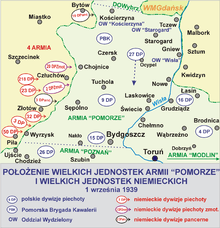Battle of Tuchola Forest
| ||||||||||||||||||||||||
The Battle of Tuchola Forest (German: Schlacht in der Tucheler Heide, Polish: Bitwa w Borach Tucholskich) refers to one of the first battles of the Second World War during the Invasion of Poland, 1939. The battle started on 1 September and ended on 5 September with a major German victory. Due to lack of coordination and poor command of forces on the Polish side and German numerical and tactical superiority, the Germans managed to cripple the Polish Army of Pomerania and connect mainland Germany with East Prussia, breaking through the Polish Corridor.[1]
Prelude

Tuchola Forest (Polish: Bory Tucholskie, German: Tucheler Heide) in Westprussia,[2] since 1920 Treaty of Versailles in the Polish Corridor, is a large forest territory. Because of its difficult terrain it was viewed by the Poles as good defensive terrain. The German troops, on the other hand, had their Truppenübungsplatz Gruppe exercise area there until 1919, and were familiar with it, like Heinz Guderian, who had been born in nearby Kulm.[3]
Polish forces in the theater were composed of elements of the Pomeranian Army: 9th Infantry Division under colonel Józef Werobej, the 27th Infantry Division[4]:53 under general Juliusz Drapella, and Czersk Operational Group under gen. Stanisław Grzmot-Skotnicki.
German forces in the theater were composed of elements of the 4th German Army under general Günther von Kluge, specifically 19th Panzer Corps (commanded by general Heinz Guderian), and 2nd Army Corps under general Adolf Strauß. Those units were based in Western Pomerania (west of the corridor).
19th Panzer Corps consisted of the 2nd Motorized Division under general Paul Bader, the 20th Motorized Division under general Mauritz von Wiktorin and the 3rd Panzer Division under general Leo Geyr von Schweppenburg. 2nd Army Corps was composed of two infantry divisions: the 3rd Infantry Division under general Walter Lichel and 32nd Infantry Division under general Franz Böhme.
Battle
Despite several tactical Polish victories, including the Skirmish of Krojanty on 1 September, a famous Polish cavalry charge, and the destruction of a German armored train near Chojnice, German forces were able to advance quickly.
Not all Polish forces were in position by 1 September and the German advance managed to generate confusion in the Polish forces. In addition, communications problems meant that the Polish forces did not act cohesively. The Poles were forced to abandon plans for a counterattack and retreated, pursued by more mobile German motorized and armored troops. The German forces had a significant amount of armor support, including over 300 tanks commanded by the famous panzer expert, General Heinz Guderian.
Most of the Polish forces were surrounded by 3 September. Some were destroyed, while others managed to break through towards Bydgoszcz.
Aftermath
Most of the Polish forces were destroyed by 5 September. The Germans were able to break through the Polish Corridor. Some German forces were ordered to erase pockets of Polish resistance in fortified areas on the Baltic Coast, while others continued their push south-east, deeper into Polish territory.
On 6 September, Adolf Hitler visited Guderian and congratulated him on his swift progress.[5]
Order of Battle
Polish
| Groups | Division or Brigade | Regiment or Battalion | |
| Army Pomorze Bortnowski |
Operational Group Czersk Grzmot-Skotnicki |
Pomorska Cavalry Brigade Zakrzewski |
2nd Chevau-légers Regiment 8th Mounted Rifles Regiment 16th Uhlan Regiment 18th Uhlan Regiment |
| Chojnice Detachment Majewski |
1st Rifles Battalion 18th Uhlan Regiment Czersk Battalion Tuchola Battalion | ||
| Kościerzyna Detachment Staniszewski |
Kościerzyna Battalion Gdynia II Battalion 62nd Infantry Regiment | ||
| 9th Infantry Division Werobej |
15th Infantry Regiment 22nd Infantry Regiment 34th Infantry Regiment 35th Infantry Regiment | ||
| 27th Infantry Division Drapella |
23rd Infantry Division 24th Infantry Division 50th Infantry Division | ||
| 15th Infantry Division Przyjalkowski |
59th Infantry Regiment 61st Infantry Regiment 62nd Infantry Regiment |
German
| Corps | Division or Brigade | Regiments | |
| 4th Army Kluge |
XIX Corps Guderian |
3rd Panzer Division Schweppenburg |
5th Panzer Regiment 6th Panzer Regiment 3rd Motorized Infantry Regiment |
| 2nd Motorized Division Bader |
5th Motorized Infantry Regiment 25th Motorized Infantry Regiment 92nd Motorized Infantry Regiment | ||
| 20th Motorized Division Wiktorin |
69th Motorized Infantry Regiment 76th Motorized Infantry Regiment 80th Motorized Infantry Regiment | ||
| II Corps Strauss |
3rd Infantry Division Lichel |
8th Infantry Regiment 29th Infantry Regiment 50th Infantry Regiment | |
| 32nd Infantry Division Böhme |
4th Infantry Regiment 94th Infantry Regiment 96th Infantry Regiment | ||
| III Corps Haase |
50th Infantry Division Sorsche |
121st Infantry Regiment 122nd Infantry Regiment 123rd Infantry Regiment | |
| Wehrmacht Reserves | 10th Panzer Division Schaal |
8th Panzer Regiment 86th Motorized Infantry Regiment | |
| 23rd Infantry Division Brockdorff-Ahlefeldt |
9th Infantry Regiment 67th Infantry Regiment 68th Infantry Regiment | ||
| 218th Infantry Division Freiherr Grote |
323rd Infantry Regiment 386th Infantry Regiment 397th Infantry Regiment |
References
- ↑ Christer Jörgensen, Chris Mann, Strategy and Tactics: Tank Warfare, Zenith Imprint, 2001, ISBN 0-7603-1016-5, p.35 Google Print
- ↑ 1896 Map of West-East Prussia with Tucheler Heide south of Danziger Bucht Bay
- ↑ Heinz Guderian: Erinnerungen eines Soldaten, "Ich hatte am 3.9 ... meinen Sohn Kurt wiedergesehen und mich dabei an den Türmen von Kulm, meiner Geburtsstadt, erfreut, die vom Ostufer der Weichsel herüberwinkten. Am 4.9 ... bei ihren Waldgefechten und endete auf dem alten deutschen Truppenübungsplatz Gruppe westlich Graudenz.", 1951,
- ↑ Zaloga, S.J., 2002, Poland 1939, Oxford: Osprey Publishing Ltd., ISBN 9781841764085
- ↑ Martin Gilbert, The Second World War: A Complete History, Owl Books, 2004, ISBN 0-8050-7623-9 Google Print, p.6
Further reading
- Steven J. Zaloga, Polish Army, 1939–1945, Osprey Publishing, 1982, ISBN 0-85045-417-4,
External links
- (Polish) Bitwa w Borach Tucholskich
Coordinates: 53°36′00″N 18°00′00″E / 53.600000°N 18.000000°E